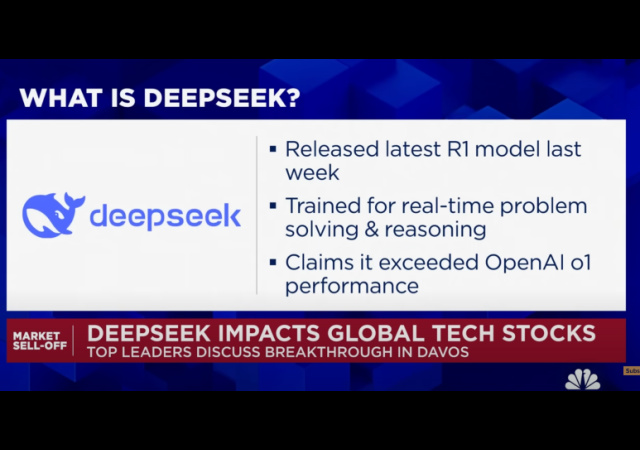Was Monday’s Tech Wreck Warranted or are Predictions of Nvidia’s Doom Premature?
“It’s entirely possible DeepSeek has been less than truthful about how many top-flight Nvidia chips it has access to and used to train its models.”

Silicon Valley venture capitalist Marc Andreessen called the debut of DeepSeek’s R1 AI model “AI’s Sputnik moment,” a reference to the Soviet Union’s launch of the first satellite into orbit in 1957. The realization that the Soviets had beat us into space intensified fears that America had fallen behind in technology. This seminal event triggered the Space Race.
Likewise, the introduction of DeepSeek’s new model seems to have sparked a similar reaction in the AI industry.
Deepseek R1 is AI's Sputnik moment.
— Marc Andreessen 🇺🇸 (@pmarca) January 26, 2025
Reports that DeepSeek’s newest models, V3 and R1, were on par with OpenAI’s ChatGPT, and developed for a fraction of the cost, sent AI chip maker (and previous market darling) Nvidia and other AI stocks into a tailspin on Monday. By the end of the trading day, Nvidia, the hardest hit, had lost nearly $600 billion – or 17% – of its market value.
CNBC reported that despite the day’s carnage, Nvidia itself, called DeepSeek’s R1 model “an excellent AI advancement.”
DeepSeek, a Chinese AI startup, was founded in 2023 by Chinese hedge fund trader Liang Wenfeng. The company “released its open-source model for download in the United States in early January, where it has since surged to the top of the iPhone download charts, surpassing the app for OpenAI’s ChatGPT,” according to Forbes.
Many experts in the field have not only declared that DeepSeek’s R1 is equal to ChatGPT, but the company claims that it cost just $5.6 million to train. In contrast, U.S. tech companies have spent hundreds of millions on training their models.
Here’s what’s being said about DeepSeek’s latest offerings:
- DeepSeek’s reasoning model R1 not only destroys the myth that China can only copy the West, it may even be poised to eclipse it in the AI tech race. … China’s artificial intelligence breakthrough is shaking the foundation of the West’s dominance in this technological arms race. (Fortune)
- “V3 and R1 AI models appear to rival the best of any U.S. company, while having been trained at a fraction of the cost. Since Nvidia’s powerful graphics processing units are one of the biggest costs of developing the most advanced AI models, investors are suddenly, and radically, questioning their assumptions about the AI business.” (Fortune)
- DeepSeek’s latest product, an advanced reasoning model called R1, has been compared favorably to the best products of OpenAI and Meta while appearing to be more efficient, with lower costs to train and develop models and having possibly been made without relying on the most powerful AI accelerators that are harder to buy in China because of U.S. export controls. (Forbes)
- DeepSeek released an AI model that appeared to perform on par with a cutting-edge counterpart from OpenAI, the U.S. firm at the heart of the AI craze. The twist: Creative engineering tricks meant DeepSeek needed far less computing power. The upshot is that the AI models of the future might not require as many high-end Nvidia chips as investors have been counting on. (The Wall Street Journal)
So, what does the introduction of R1 mean for Nvidia which was, until Monday, the most magnificent of the stock market’s “Magnificent Seven” companies? Was the hysteria warranted or are predictions of Nvidia’s doom premature?
Fortune’s technology reporter Jeremy Kahn provided a lengthy explanation for why he believes “DeepSeek’s impact could, counterintuitively, increase demand for advanced AI chips.” (Although the article is behind a paywall, it was published on YahooFinance.)
The reason is partly due to a phenomenon known as the Jevons Paradox.
Named for 19th Century British economist William Stanley Jevons, who noticed that when technological progress made the use of a resource more efficient, overall consumption of that resource tended to increase. This makes sense if the demand for something is relatively elastic—the falling price due to the efficiency improvement creates even greater demand for the product.
Jevons Paradox could well come into play here. One of the things that has slowed AI adoption within big organizations so far has been how expensive these models are to run. This has made it hard for business to find use cases that can earn a positive return on investment, or ROI. This has been particularly true so far for the new “reasoning” models like OpenAI’s o1. But DeepSeek’s models, especially its o1 competitor R1, are so inexpensive to run that companies can now afford to insert them into many more processes and deploy them for many more use cases. Taken across the economy, this may cause overall demand for computing power to skyrocket, even as each individual computation requires far less power.
He cites a social media post from former Intel CEO Pat Gelsinger who wrote that “computing obeys the gas law. Making it dramatically cheaper will expand the market for it…this will make AI much more broadly deployed. The markets are getting it wrong.”
Kahn continues:
Another reason that demand for advanced computer chips is likely to continue to grow has to do with the way reasoning models like R1 work. Whereas previous kinds of LLMs became more capable if they used more computer power during training, these reasoning models use what is called “test time compute”—they provide better answers the more computing power they use during inference. So while one might be able to run R1 on a laptop and get it to output a good answer to a tough math question after, say, an hour, giving the same model access to GPUs or AI chips in the cloud might allow it to produce the same answer in seconds. For many business applications of AI, latency, or the time it takes a model to produce an output, matters. The less time, generally the better. And to get that time down with reasoning models still requires advanced computing chips.
Finally, Kahn believes “it’s entirely possible DeepSeek has been less than truthful about how many top-flight Nvidia chips it has access to and used to train its models.”
Many AI researchers doubt DeepSeek’s claims about having trained its V3 model on about 2,000 of Nvidia’s less capable H800 computer chips or that its R1 model was trained on so few chips. Alexandr Wang, the CEO of AI company Scale AI, said in a CNBC interview from Davos last week that he has information that DeepSeek secretly acquired access to a pool of 50,000 Nvidia H100 GPUs (its latest model). It is known that HighFlyer, the hedge fund that owns DeepSeek, had amassed a substantial number of less capable Nvidia GPUs prior to export controls being imposed. If this is true, it is quite possible that Nvidia is in a better position than investor panic would suggest—and that the problem with U.S. export controls is not the policy, but its implementation.
At 12 p.m. ET on Tuesday, the price of NVDA stock was holding onto a 5-point gain on volume of 281 million shares, already surpassing its 30-day average daily trading volume of 209 million shares.
The news from DeepSeek on Monday came as a lightning bolt. Investors panicked and overreacted as they always do. The stock market is driven by fear and greed, and at least for the moment, they look to be about equal.
Prior to Monday’s tech wreck, shares of Nvidia had been priced to perfection. In other words, it was poised for a correction. All it needed was a little push. And DeepSeek gave it a shove.
A warning:
Before downloading the app, be aware that, like TikTok and other Chinese apps, China will be collecting your data including “your IP, keystroke patterns, device info … and stor[ing] it in China, where all that data is vulnerable to arbitrary requisition from the [Chinese] State.”
Apparently, your keystroke patterns, how fast you type, how long you press on each key, and the amount of pressure applied, are as unique as your fingerprints and are now being used as a tool to identify individuals. This method is “a form of behavioral biometrics” called “keystroke dynamics.”
Just fyi, @deepseek_ai collects your IP, keystroke patterns, device info, etc etc, and stores it in China, where all that data is vulnerable to arbitrary requisition from the 🇨🇳 State.
From their own privacy policy: pic.twitter.com/wueJokHcn3
— Luke de Pulford (@lukedepulford) January 27, 2025
Elizabeth writes commentary for The Washington Examiner. She is an academy fellow at The Heritage Foundation and a member of the Editorial Board at The Sixteenth Council, a London think tank. Please follow Elizabeth on X or LinkedIn.
Donations tax deductible
to the full extent allowed by law.








Comments
You can usually speed anything up 3x by coding in assembler. Smaller and faster.
Only if your compiler is clueless to the underlying HW.
Nothing can compensate for code not written for performance.
Both statements are moot since AI is the dot com nothing burger of this generation.
It seems to be thriving in the same ecosystem that propped up DEI and COVID. I’m disappointed Trump is on the wagon because it’s garbage.
When the PC came along, task after task was made faster and easier. Everyone bought it and used it daily. It was Gates/Grove money printing machine. AI has a trillion + invested and hasn’t solved a single thing except to show us pictures of a black George Washington. Most things you would point to are simply automation that required no special compute power.
AI- It’s the thing everyone is trying to uninstall and avoid. It’s spyware… at least China isn’t really hiding it.
The upside…. Linux may finally have its day for taking over desktop computing.
Yes to Linux!
Fairly certain a good deal of Millennial/Gen Z coders have no clue about assembly language.
Forty-five years ago, I could rewrite any piece of scientific code in assembly language and be confident of at least doubling its speed, mainly because the compiler did clunky mechanical register allocation and was unaware of any coding idioms. Modern compilers are an entirely different breed. At higher optimization levels, they rarely miss a trick. You might occasionally outsmart them, but tripling your performance routinely is out of the question. Play around with the Compiler Explorer if you doubt it.
I think Liang Wenfang and his buddies shorted the market before the weekend and on Monday laughed all the way to the bank. Deepseek will end up having more holes in it than swiss cheese and yes, they did copy someone else’s product. But well done Mr Wenfang.
I predict the snake will eat it’s tail when Deepseek enters into an inescapable FOR loop.
The combination of Communist China and AI makes it almost certain that most of this story is composed of lies.
Following the trend of Chinese business reputation, they probably just ran a bunch of chatgpt iterations and trained it on that.
And that’s above and beyond the lies AI LLMs generate.
Maybe they had ChatGPT write the propaganda?
Requires fewer Nvidia processors, enabling corporations to build their own private LLMs. Net results: more processors.
According to the following, Deep Seek V3 is open source.
https://deepseekv3.org/
So If you are worried about the Chinese spying on you, modify the source code and recompile. Am I missing something?
I had a subscription to ChatGPT and tested it on some math problems. For example, compute the determinant of a 20th order Hilbert Matrix. Failed miserably. I had to help it, but it still screwed up badly. This computation has a known analytical solution. I knew the answer using Mathematica. I also asked it a question about global warming and the Navier-Stokes equations. I got an entirely political answer, avoiding the question. My lawyer daughter tried it on some cases and it made up authorities. The AI people call that “hallucinating,” which is a euphemism for lying.
My tests were last year so perhaps ChapGPT has improved since then. Based on my experience, I don’t trust it.
Hallucinations are exclusively a side-effect of Western civilization AIs.
The far eastern ones “experience visions.”
Yes. The biggest threat from AI is from all the people that “believe” in it.
“Silicon Valley venture capitalist Marc Andreessen called the debut of DeepSeek’s R1 AI model “AI’s Sputnik moment,” a reference to the Soviet Union’s launch of the first satellite into orbit in 1957. The realization that the Soviets had beat us into space intensified fears that America had fallen behind in technology.”
Let’s set the record straight on this. The US government decided that our satellite program had to be civilian, and established NASA. The NASA rocket blew up on the first attempt. So we used a Redstone rocket to launch the first American satellite. The Redstone was basically a German V2 with an improved fuel pump. We could have been first to launch an earth satellite.
The Russians had big military rockets that could launch heavy payloads because their warheads were much heavier than our’s. Our national Labs, Los Alamos and LRL (Lawrence Radiation Lab at Livermore) had much better nuclear warhead designs than the Russians because they lacked our computer technology. We were never actually behind the Russians.
When the quantium barrier is broken Adam will finally have what Eve desired…his own understanding.
The consequences of Deep Seek go beyond the effect on NVDA stock which suffered a big crash on Monday. Deep Seek reveals the weakness of the Silicon Valley’s reliance on hordes of cheap H-1Bs. All this gets covered in the “Competency Crisis” written by David A. Janello.
https://nuclearoptiontrading.substack.com/p/the-competency-crash
Excerpt:
“Musk describes the philosophy of the quintessential non-technical manager, which he is. His H1-B visa “employees” are cheaper per hour than highly skilled American engineers and developers. But they are much less productive. The Silicon Valley solution to the technical skills gap is to hire larger teams of engineers, on the assumption that the larger team will still be cheaper than using more expensive native talent.”
I was very disappointed to see Trump abandon his America First philosophy and support the H-1B program which hurts American engineers. Trump even asserted that he was always in favor of H-1Bs. Boo. An obvious falsehood. Now Deep Seek changes everything. Let’s not forget that Americans at Bell Labs invented Unix, and C which are the fundamental building blocks of most of today’s software. I knew some of the guys at Bell Labs before it got destroyed by the business types. A great loss to America.
In my opinion, this is the real story about Deep Seek, not what’s happening to one over priced stock.
AI is only as good as its creators and what info they allow to be used. Does anyone believe the Chinese are going to allow a completely neutral knowledge protocol? They have already loaded it against anything to do with Taiwan and who knows what else they have perverted. Throw in the spying and data collecting on all users and I predict a dark future for them.
Microsoft has made challenges to DeepSeek citing there may have been distillation (stealing) of their AI back Open AI models.
I’ll expect legal challenges to DeepSeek shortly by next week.
Glad to hear it.
I’m a little confused here. We’re already concerned about domestic AI models leaning to the left. When people start relying on AI searches to get their information, if everything is biased toward the left, I see that as problematic.
But this new AI being hailed by the industry was developed and “trained” by our existential enemy. Is no one concerned that this model is pre-designed to be biased against the west and to tilt everything in the favor of China?
To be clear, I don’t really understand the technology behind AI so perhaps I’m reading too much into it, but it seems to me that this could be orders of magnitude more damaging to our culture than stupid Tik Tok videos, but we’re not only allowing it, but encouraging it.
I don’t get it.
Am I the only one who realizes that this is just too bloody convenient now that Tik-Tok will not be available as a source of intel for the chi-coms? Is anyone actually surprised by this?
Even if all of DeepSeek’s propaganda is true… WHO CARES?
“AI” is one of the biggest frauds perpetrated on the tech-gullible in history. Even more than Windows ME. These things aren’t intelligent in any way comparable to a human, and they’re mostly just really big, really complicated, really power-hungry algorithms that would be classified as worms if it weren’t for the hype.
The biggest danger from AI is the number of people who will follow it gladly to Carousel just because they’ve been told it’s “AI”.
(Yes, that’s a movie/book reference for all you young people. Go look it up.)